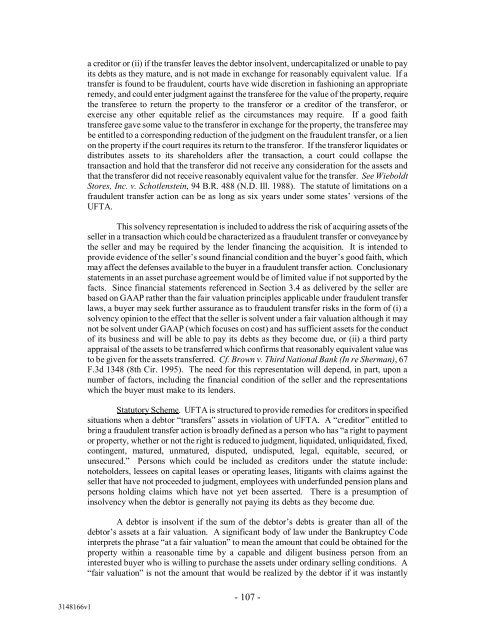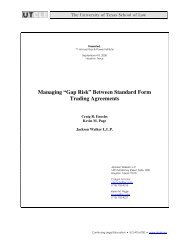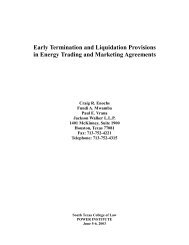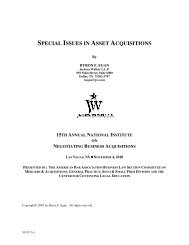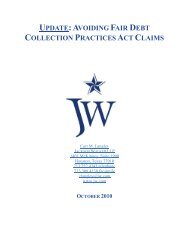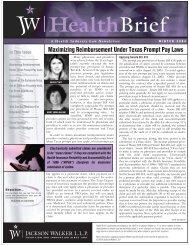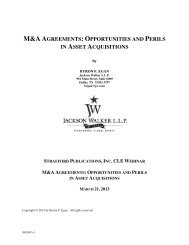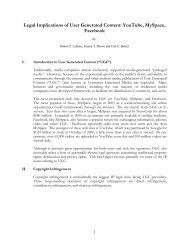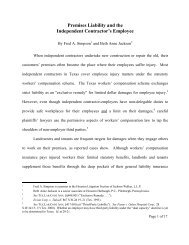asset acquisitions - Jackson Walker LLP
asset acquisitions - Jackson Walker LLP
asset acquisitions - Jackson Walker LLP
You also want an ePaper? Increase the reach of your titles
YUMPU automatically turns print PDFs into web optimized ePapers that Google loves.
a creditor or (ii) if the transfer leaves the debtor insolvent, undercapitalized or unable to payits debts as they mature, and is not made in exchange for reasonably equivalent value. If atransfer is found to be fraudulent, courts have wide discretion in fashioning an appropriateremedy, and could enter judgment against the transferee for the value of the property, requirethe transferee to return the property to the transferor or a creditor of the transferor, orexercise any other equitable relief as the circumstances may require. If a good faithtransferee gave some value to the transferor in exchange for the property, the transferee maybe entitled to a corresponding reduction of the judgment on the fraudulent transfer, or a lienon the property if the court requires its return to the transferor. If the transferor liquidates ordistributes <strong>asset</strong>s to its shareholders after the transaction, a court could collapse thetransaction and hold that the transferor did not receive any consideration for the <strong>asset</strong>s andthat the transferor did not receive reasonably equivalent value for the transfer. See WieboldtStores, Inc. v. Schotlenstein, 94 B.R. 488 (N.D. Ill. 1988). The statute of limitations on afraudulent transfer action can be as long as six years under some states’ versions of theUFTA.This solvency representation is included to address the risk of acquiring <strong>asset</strong>s of theseller in a transaction which could be characterized as a fraudulent transfer or conveyance bythe seller and may be required by the lender financing the acquisition. It is intended toprovide evidence of the seller’s sound financial condition and the buyer’s good faith, whichmay affect the defenses available to the buyer in a fraudulent transfer action. Conclusionarystatements in an <strong>asset</strong> purchase agreement would be of limited value if not supported by thefacts. Since financial statements referenced in Section 3.4 as delivered by the seller arebased on GAAP rather than the fair valuation principles applicable under fraudulent transferlaws, a buyer may seek further assurance as to fraudulent transfer risks in the form of (i) asolvency opinion to the effect that the seller is solvent under a fair valuation although it maynot be solvent under GAAP (which focuses on cost) and has sufficient <strong>asset</strong>s for the conductof its business and will be able to pay its debts as they become due, or (ii) a third partyappraisal of the <strong>asset</strong>s to be transferred which confirms that reasonably equivalent value wasto be given for the <strong>asset</strong>s transferred. Cf. Brown v. Third National Bank (In re Sherman), 67F.3d 1348 (8th Cir. 1995). The need for this representation will depend, in part, upon anumber of factors, including the financial condition of the seller and the representationswhich the buyer must make to its lenders.Statutory Scheme. UFTA is structured to provide remedies for creditors in specifiedsituations when a debtor “transfers” <strong>asset</strong>s in violation of UFTA. A “creditor” entitled tobring a fraudulent transfer action is broadly defined as a person who has “a right to paymentor property, whether or not the right is reduced to judgment, liquidated, unliquidated, fixed,contingent, matured, unmatured, disputed, undisputed, legal, equitable, secured, orunsecured.” Persons which could be included as creditors under the statute include:noteholders, lessees on capital leases or operating leases, litigants with claims against theseller that have not proceeded to judgment, employees with underfunded pension plans andpersons holding claims which have not yet been asserted. There is a presumption ofinsolvency when the debtor is generally not paying its debts as they become due.A debtor is insolvent if the sum of the debtor’s debts is greater than all of thedebtor’s <strong>asset</strong>s at a fair valuation. A significant body of law under the Bankruptcy Codeinterprets the phrase “at a fair valuation” to mean the amount that could be obtained for theproperty within a reasonable time by a capable and diligent business person from aninterested buyer who is willing to purchase the <strong>asset</strong>s under ordinary selling conditions. A“fair valuation” is not the amount that would be realized by the debtor if it was instantly3148166v1- 107 -


